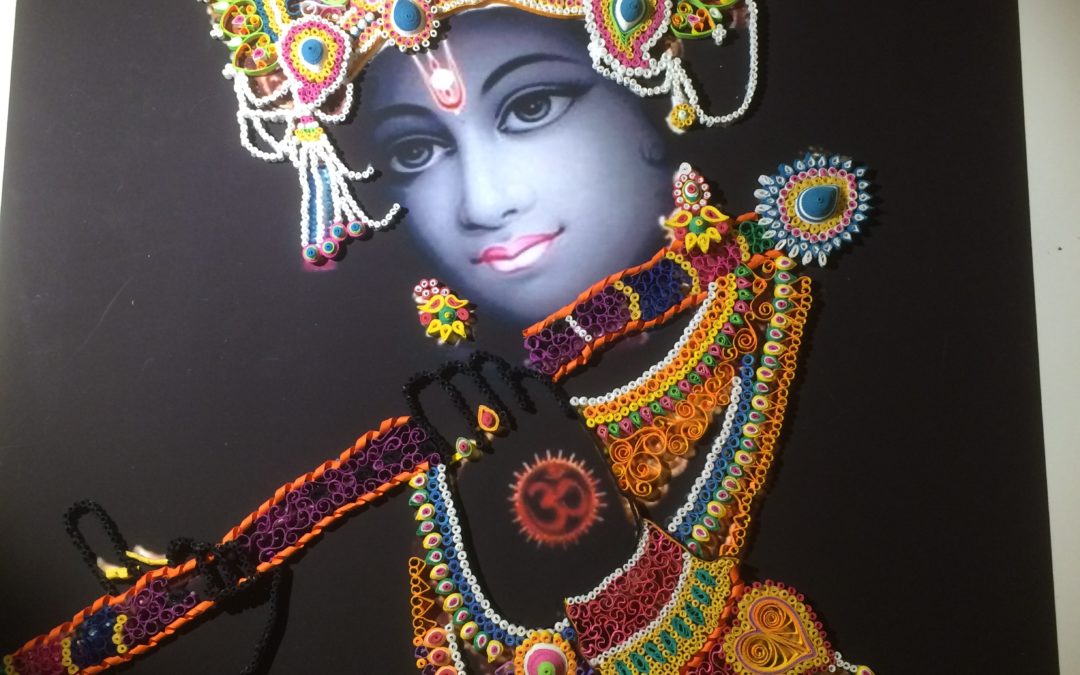[Paper Quilling Artwork: Shally Dhiman]
UNDERSTANDING THE TRUE NATURE OF DEVOTION:
IS BHAKTI REALLY DUALISTIC?
Bhakti (Sanskrit: भक्ति) is devotional worship directed to a chosen deity (iśta-devatā) or to one Supreme Lord. It is natural to think that bhakti is dualistic since it involves the bhaktā (devotee) and the chosen object of worship (bhagavān).
Does bhakti really involve duality? In order to understand the depth of this question, let’s take an example of a devotee who is worshiping Lord Rāma.
The worship of Lord Rāma can be invoked or conceived in many forms by the devotees, such as:
- Rāma who was the son of king Dasharatha.
- Rāma who was the husband of Sita.
- Rāma who was the brother of Lakshamana and Bharata.
- Rāma who went to a 14 years exile, banavās.
- Rāma, the wielder of bow, who killed Rāvana in the war.
- Rāma who was upholder of righteousness, maryāda purushotama Rāma.
- Rāma as a Cosmic Being (vishva-rupa) who dwells (Rāmana) in every atom–
रोम रोम में बसने वाले राम
…and finally,
- Rāma who is the very Self (ātmā) of all and everything.
As we can see, all the forms listed above except the last one (where the Lord Rāma is viewed as the very Self—ātmā—of all), will involve seeming duality.
Based on the past impressions (saṁskāras) of the devotee, when s/he will meditate on Rāma, s/he will invoke a particular image/view of the Lord Rāma in mind.
Bhakti essentially means love. Nārada defines bhakti as of the nature of Supreme Love: परमप्रेमरूपा parampremarupa.
So, it all depends upon a devotee’s state of mind (bhāvanā) at the time of worship whether the bhakti is dualistic or not.
Ādi Śaṅkara in Vivekachudamani, the Crest Jewel of Wisdom, defines bhakti as follows:
मोक्षकारणसामग्र्यां भक्तिरेव गरीयसी ।
स्वस्वरूपानुसन्धानं भक्तिरित्यभिधीयते ॥ ३१॥
mokṣakāraṇasāmagryāṁ bhaktireva garīyasī |
svasvarūpānusandhānaṁ bhaktirityabhidhīyate || 31||
Among all the means conducive to Liberation (moṣka), devotion (alone) is supreme. To seek earnestly to know one’s true nature (svasvarūpa) is called devotion (bhakti).
For a downloadable complete pdf of Śaṅkara’s Vivekachūḍāmaṇi, please see:
http://realization.org/down/sankara.vivekachudamani.chaitanya.pdf
THREE GRADATIONS OF BHAKTI
Swāmī Paramārthānanda ji, a modern Vedānta teacher, explains bhakti in 3 different stages, as follows:
- Aneka-Rupa Bhakti: Worship offered to the Lord in many forms of deities, to one’s chosen iśta-devata.
- Eka-Rupa Bhakti: Worship offered to one Supreme Being
- Arupa Bhakti: Formless Devotion which is directed toward Pure Consciousness, the ever present Awareness (e.g., meditating on Ȯm, the symbol of Brahman)
Swami Dayananda Saraswati ji used to say that in Hinduism, we do not say ‘there is only one God.’ We say there is God Only!
Vasudeva Sarvam (B.G. 7.19)
So, it all depends upon one’s state of mind.
In the epic Ramāyaṇa, we find that Sri Rāma asked Sri Hanumān-ji a question in the assembly: “O Hanumān, what do you think of me in relation to yourself?”
Tears were rolling down Hanumānji’s cheeks. Full of devotion and suffused with jñāna, the wisest of the beings said, “O Lord…
- From the standpoint of the body, I am your servant (deha-buddhyā tu dās’aham)
- As an individual, I am a part of you (jīva-buddhyā tvad aṁśkaḥ)
- But as the pure Self, we are One (ātma-buddhyā tvam-evāhaṁ)
- This is my firm conviction (iti me niścayā matiḥ).”
Grace Notes: This answer represents the whole journey of the individual entity to the universal Self. These three viewpoints in fact represent three different stages of the spiritual evolution of the aspirants. When one thinks oneself as a body, then, the Lord is the Almighty and one is Lord’s devotee. When one thinks of oneself as the jivātman, the embodied self, then one is a part of the Lord, being a part of the manifestation. When one realizes one’s true nature to be the inner Witnessing-Consciousness (Brahman), the Self and the Lord are one only.
BHAKTI AND PARĀ-BHAKTI IN THE GĪTĀ
In chapter 7.16, Śri Kṛṣṇa explains that there are four types of devotees: the seeker after worldly possessions, the distressed, the seeker after knowledge, and the wise person. Then, in the next verse B.G. 7.17) Śri Kṛṣṇa states that of these four, the best is the wise person:[1] “I am extremely dear to the wise person and the wise person is extremely dear to Me.” Such a person is exceeding dear to the Lord.
Śaṅkara, in his commentary on B.G. 7.17, explains why a wise person is exceedingly dear to the Lord as follows: ‘Since I am his very Self, I am excessively dear to the wise person—it is well-known to all in this world that the Self is dear to everyone…. And the wise person is My very Self and is therefore very dear to Me.’ (Alladi Mahadeva Sastry’s trans., p. 215).
Finally, in the next verse, B.G. 7.18, the Lord states definitely that although all four types of devotees are dear to Me, but the wise person (jñāni), I deem to be My very Self: jñānī tvātmaiva me matam ज्ञानी त्वात्मैव मे मतम्. Śaṅkara further explains why the wise person is so dear to The Lord: “It is My conviction that the wise person is the very Self, not different from Me.”
Thus, devotion to the Lord as the inner Self of all, is spoken of as the highest devotion in the Gītā. And such a devotion—that is, devotion to the wisdom of the Self or Absolute Reality (Brahman)—is called परा भक्ति, the Supreme Devotion, in B.G.18.54.
In summary, when one worships the Lord as one’s very own Self, there is no subject-object duality involved.
At several place in the Gītā, we find the Lord reiterating the fact of the One Self that resides in the heart of all beings, such as:
aham ātmā guḍākeśa sarvabhūtāśayasthitaḥ: अहम् आत्मा गुडाकेश सर्वभूताशयस्थितः B.G. 10.20
I am the Self seated in the hearts of all beings. [2]
kṣetrajñaṃ cāpi māṃ viddhi sarvakṣetreṣu bhārata क्षेत्रज्ञं चापि मां विद्धि सर्वक्षेत्रेषु भारत: B.G. 13.2
Do know Me as the Knower in all fields. [that is, I am the Witnessing-Consciousness in all beings]
samaṃ sarveṣu bhūteṣu tiṣṭhantaṃ parameśvaram समं सर्वेषु भूतेषु तिष्ठन्तं परमेश्वरम् 13.27 [3]
The Supreme Lord dwells alike in all beings.
īśvaraḥ sarvabhūtānāṃ hṛddeśerjuna tiṣṭhati ईश्वरः सर्वभूतानां हृद्देशेर्जुन तिष्ठति 18.61:
The Lord dwells in the heart of all beings.
It is important to remember that, in the Gītā, wherever Śri Kṛṣṇa has used the word “mama” to refer to Himself, the word has been used in the technical sense to mean the Universal Self that abides as the inmost Self of all beings.
True bhakti consists of surrendering to the Divine that dwells within all.
This is the final message of the Gītā.
——————————————–
[1] The wise person is one who knows the Lord in reality in the true sense.
[2] Sri Ramana Maharshi used to regard B.G. 10.20 to be the essence of the whole Gītā.
[3] This is perhaps the most important single verse in the entire Gītā. It not only tells us that the Ultimate Reality dwells in all beings (as the inner Self of all) but also provides the methodology to realize It in our own direct experience. How? By seeing the Imperishable amidst the perishable (vinaśyatsv avinaśyantaṃ). Only he who sees one’s own Self as the Changeless Consciousness amidst the ceaselessly changing phenomena of body, mind, and the world, truly sees—declares the Gītā. According to Śaṅkara, realizing the immutability of one’s own inner Self constitutes Liberation, mokṣa. Śaṅkara points out that the devotion of Knowledge (jñāna-niṣthā) consists in an intent effort to establish a continuous current of idea of the inner Self (pratyagātmā). (See Śaṅkara’s commentary on B.G.18.55, Sastry, trans., p. 494)


Recent Comments